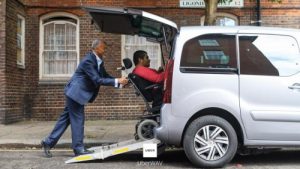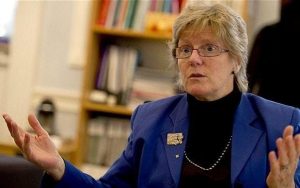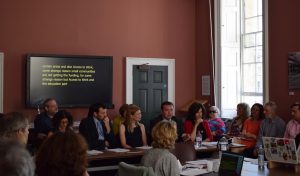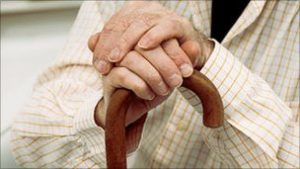Latest News
Scandal of the young carers under FIVE: Staggering 160 infants are looking after a family member
And about 130,000 carers aged five to 17 may be unknown to local authorities, according to the Children’s Commissioner for England.
Anne Longfield said it was ‘absolutely unacceptable’ that so many young carers were going under the radar and she accused town halls of failing them.
She also warned that this is likely to be the tip of the iceberg because councils did not count children who looked after family, friends and neighbours who were hooked on alcohol and drugs.
For the first time, the commissioner has collected data to find out how children who look after sick and disabled relatives are themselves supported.
The 2011 census identified 166,363 children providing unpaid care. Based on a survey of 152 local authorities, she calculated 33,506 young carers received support, meaning 132,857 – or about 80 per cent – did not get any help.
Miss Longfield found that many councils prioritised their legal duty to assess referrals over actually providing support.
One service provider, speaking anonymously, said: ‘We are essentially carrying out assessments as a tick-box exercise. We are prioritising bureaucracy and not actually considering what we need to best help young carers.’
Miss Longfield said: ‘Caring for relatives often places heavy emotional and physical burdens on children. It can lead to them missing out on education and also opportunities to make and spend time with friends.
‘I am also concerned that some local authorities say that they are supporting young carers under the age of five. I will be following this up with those local authorities to clarify exactly what it is that these children are doing.’
She added: ‘It is absolutely unacceptable to have so many children with caring responsibilities going under the radar’.
The report found that of the 18,746 young carers who were brought to the attention of councils in 2015-16, a third had not received an assessment.
A report three years ago found that one in 12 young carers spent 15 hours a week looking after a parent or sibling, that one in 20 miss school and that they are 50 per cent more likely to have special needs or an illness.
Councillor Richard Watts, of the Local Government Association’s children and young people board, said councils were facing a £1.9 billion funding gap for children’s services by 2020.
He added: ‘Unfortunately, this means that councils are forced to make increasingly difficult decisions about the level of support they are able to provide to children and young people in their area’.
A Department for Education spokesman said: ‘Young carers are this country’s unsung heroes, selflessly providing support for the people they love, but their own needs can often be overlooked. That’s why we changed the law to make sure young carers are identified and supported as early as possible, and councils are responsible for delivering this. Next year we will be publishing a strategy looking at the issues affecting these children and what more can be done to give them the help they need.’

Braille smartwatches, bespoke wheelchairs… technology that matters
According to the latest figures, 12.6 million UK adults lack basic digital skills and 5.3 million have never been online. Only two thirds of disabled people have internet access, compared to 88% of the UK population as a whole, and a quarter of disabled adults have never been online. Researchpublished this month also found that nearly three quarters of people with disabilities experience problems accessing many websites. The question is whether the government’s long-awaited digital strategy will address these issues.
Yet digital technology can also provide the means for people with disabilities or physical and mental health conditions to lead more independent, fuller lives and participate in activities that would otherwise not be possible. More than a quarter of the entries to this year’s Nominet Trust 100 use technology to promote inclusion. This annual list identifies the most inspiring examples across the globe of technology used for social good, and is published on 14 December.
Several entrants focus on using communication to boost inclusion. The Open Voice Factory, for example, is the first open-source software providing communication aids. According to Joe Reddington, one of its co-founders, more than 30,000 people in the UK need a device to help them speak but at £2,000 cannot afford standard aids. “We produce a free web app that can be put on a much cheaper tablet that you might already have at home,†he says. The software – in the final stages of testing – allows family or carers to customise it with personal vocabulary, stories and in-jokes.
Hand Talk is an app that instantly translates text or audio into sign language with the help of a virtual interpreter, Hugo, so that deaf people can communicate in real time with anyone, anywhere. EVA Park, developed by the Stroke Association-funded EVA project at City University, London, creates a virtual reality environment that helps people with aphasia to communicate again. Disrupt Disability has also created an open-source platform. This allows wheelchairs to be tailor-made, using an online library of free designs for different components; many elements will be suitable for digital production, including 3D printing. Its founder, Rachael Wallach, who has impaired mobility, explains the thinking behind it: “My wheelchair has over 30 different elements that have been tailored to me,†she says. “But it cost £3,000. In a country like Laos, that’s six times the average annual salary, so it’s just not affordable.†The World Health Organisation estimates that more than 65 million people need a wheelchair, yet 80% – some 52 million – cannot afford a wheelchair or one customised to their needs.
Not all the Nominet Trust 100 entries are designed to make products more affordable. Dot Watch, described as the first braille smartwatch, provides social media, news and messages, and is due to go on sale in the UK next year with a price tag of around £2,500.
Pips are bluetooth-enabled, palm-sized buttons attached to walls and furniture. They emit beeps when pressed, to turn walking into a game, thereby helping children with no or partial sight to learn to walk confidently. Another movement entrant, Walk With Path, has developed two shoe products that reduce the risk of falls in vulnerable people. The first, Path Feel, is an insole that helps wearers with sensory deficit on the bottom of their feet, such as people with diabetes or multiple sclerosis, to feel the floor better by enhancing sensory perception of the environment, allowing them more confident movement. The second, Path Finder, is specially designed for Parkinson’s patients who suffer from freezing of gait, where they feel as if their feet suddenly become glued to the floor. A small device is attached to the shoe to prevent this sensation. Both products will be available in 2017.
Seven projects that make the top 100 focus on safety. They include Tootoot, a safeguarding app to allow pupils to report bullying anonymously and teachers to act on it more quickly. Health projects also feature prominently. Nightscout helps patients with type 1 diabetes to share glucose levels, while three products (MyBivy, Bravemind and SimSensei) focus on helping people with post-traumatic stress disorder.
Perhaps the most unusual entrant is the South West Open Youth Orchestra, the UK’s only disabled-led regional youth orchestra. Its founders, OpenUp Music in Bristol, have developed a range of digital instruments that can be played with any part of the body, including the eyes. “Being part of an orchestra is new to me. I love it, and feel a kind of freedom and belonging,†says Bradley Warwick, 21, who plays the clarion (which sounds like a digital organ) with his eyes.
“Disability should never be a barrier to enjoying music and getting involved.â€The government says it is still working with industry on its digital strategy, which includes improving access to technology. “We are working hard to help people who can’t use online services independently get the support they need,†says Matt Hancock, the minister of state for digital and culture. “We have also announced plans to make training in basic digital skills free for adults in England who need it, and have set up the Council for Digital Inclusion which brings together leaders from business, charities and government to come up with innovative ways to help everyone get online.†But for now, too many barriers remain.
• A full list of the Nominet Trust 100 can be found at socialtech.org.uk

Wheelchair users can now book an Uber in London using the app with UberWAV
This was introduced to give wheelchair users greater choice when travelling around their city.
Just like any other vehicle you can request using Uber, WAV is booked via the Uber smartphone app and offers a reliable, affordable and safe option to wheelchair users who want to travel easily around London.  Costing the same as Uber’s affordable uberX option, uberWAV offers parity and access for wheelchair users.
Since launching in May 2016, wheelchair users in London have already made thousands of journeys using the uberWAV and on average, wait just 15 minutes for a car to arrive.
uberWAV was recently recognised for this achievement in winning the Extra Costs Award at the Disability Smart Awards 2016. This award is in collaboration with the Extra Costs Commission and supported by leading disability charity Scope, and was awarded to Uber for providing an option via the Uber platform that is geared towards reducing extra costs for disabled people and their families.
In order to make the rider’s experience as smooth as possible, the journey only begins once the rider is safely secured into the vehicle, meaning wheelchair users don’t have to rush to get in the vehicle. In order to ensure the safety of riders who choose WAV, all vehicles have four-point tie-down safety straps, ensuring both rider and the specially-trained partner driver feel safe on their journey.  The flexibility of the Uber app allows users to track their journey and allows for immediate feedback via a ratings system from both the rider and the partner driver.
This instantaneous system helps to alleviate the inconvenience of lengthy complaint procedures and eliminates the need to speak to an operator.  All journeys are also paid electronically, meaning that there is no need to carry large amounts of cash. Partner drivers are trained by Transport For All, a specialist organisation that aims to give drivers the tools and attitude to ensure high levels of customer service for disabled passengers.
Similarly, Uber offers ASSIST, another option for those with limited mobility. ASSIST offers specially-trained partner drivers for those who need extra assistance when travelling. As with uberWAV, uberASSIST is also bookable via the Uber app.
Get £15 off your first WAV or ASSIST ride by signing up to Uber at: http://get.uber.com/invite/DISRIGHTS17

Keep on working into old age for the good of your health says top doctor
Prof Dame Sally Davies will tell those aged 50 to 70 that they are better off staying in work, or else taking up new hobbies to keep physically and mentally active in retirement.
The chief medical officer, who is 67, said she had no plans to retire, as she urged others to follow suit.
Her annual report on the state of the public’s health will urge people not to slow down the pace of life as they hit their 60s.
The report is expected to suggest that people who remain in paid employment past retirement age or involved in community and voluntary work improve their chances of staying healthier for longer.
Dame Sally will say: “People are living longer than ever and so retirement presents a real opportunity for baby boomers to be more active than ever before. For many people it is a chance to take on new challenges, it is certainly not the start of a slower pace of life it once was.â€
She said staying in work was one way to boost health – but that taking up new activities on retirement was another way to boost the health.
“Staying in work, volunteering or joining a community group can make sure people stay physically and mentally active for longer. The health benefits of this should not be underestimated.â€
By 2020, a third of British workers will be aged over 50, estimates show.
More than three quarters of people aged between 50 and pension age are still in active employment, along with 12 per cent of those over pension age, which is 62 for women and 65 for men.
The report will say that while many pensioners enjoy the benefits of retirement, in many it brings feelings of social isolation.
Dame Sally has previously caused controversy with strict advice, counselling drinkers to “do as I do†and think about the risks of cancer before having a glass of wine.
Last month she urged parents to stop children from helping themselves to snacks from the fridge, in a bid to tackle the obesity crisis.
On Monday health watchdogs published advice, saying GPs should encourage widows and divorcees to take up singing and dancing to stave off dementia and stay physically healthy.
The National Institute for Health and Care Excellence (Nice) said more should be done to prevent loneliness in retirement.
The guidance from Nice says family doctors should be told to offer “tailored community-based physical activity programmes†to older people most “at risk of a decline in their independence and well beingâ€.
Research suggests that social isolation increases the risk of dementia, while more active lifestyles have been shown to protect against a host of diseases and the advance of frailty.
The new quality standard from Nice urges doctors to identify those – such as the recently bereaved, divorced or retired – who might lose opportunities to socialise.
It also says GPs should target those who have recently had to give up driving, and those who are caring for others as those who might not be getting the chance to take part in social activities.
Doctors should offer such patients a range of activities, the guidance suggests.
Dancing and swimming clubs, singing programmes run by choirs, volunteering and helping children with reading in schools are all singled out as hobbies which could prevent isolation.
In October the pop star Phil Collins announced plans to come out of retirement.
The 65-year-old former Genesis frontman will play five nights at London’s Royal Albert Hall next summer as well as dates in Cologne and Paris.
The former Genesis drummer officially retired in 2002.
But Collins, who has previously spoken about his battle with the bottle following a divorce fight with his third wife – with whom he later got back together – told a press conference that retirement was “a funny word”.
He said: “I stopped work because I wanted to be a dad at home. As bad luck would have it, as soon as I retired, my family split up.
“I didn’t have anyone to go home to. That’s why I started drinking.”
But the drummer and singer said of his retirement: “I’ve changed my mind.
“I’m living with my young kids. They want me to go out on the road and do my thing, and why not?”

MPs and peers offer plan to support a million disabled people into work
The All Party Parliamentary Group on Disability will be launching their report, “Ahead of the arc†from 3pm on December 7th in the Boothroyd Room of Portcullis House. The report highlights that on current trends and policies the Government is certain to miss its target to halve the disability employment gap.
It offers the Government details of what new interventions in the economy will be required for it to succeed in fulfilling its manifesto commitment to halve the gap between the employment rate of disabled people and that of non-disabled people by 2020.
The report focuses upon three policy areas currently under-utilised or neglected by Government:
1) A right to return to work for newly disabled workers to retain their jobs
2) Using the Government’s leverage as the biggest purchaser of goods and services in the economy to stipulate disability inclusive recruitment and retention in public sector contracting
3) Ensuring that growth sectors of the economy such as construction, care, energy generation and food and drink etc have sector wide policies that target disabled people as the workers who will fill future skills shortages in these sectors.
Dr Lisa Cameron MP and chair of the APPG on Disability said, “This report looks at factors that the DWP green paper on employment and disability largely overlooks – are there enough future vacancies and how can Government ensure that disabled people are able to either create jobs or take opportunities in major areas of the economy? It argues for a new relationship with disabled people in which Government spending  also has a social dividend that helps them gain work; and Government funded bodies such as Innovate UK and the Business Bank target a proportion of their funding at supporting disabled people. That funding could be used to help disabled people become self-employed where appropriate, start businesses, invent products or services that overcome their barriers to the labour market or even create new markets that benefit everyone.
Philip Connolly , policy manager of Disability Rights UK and one of the authors of the report said, “New and additional job opportunities in the economy will make back to work support more effective and in turn provide a real incentive for disabled people to move off benefits, where their health condition makes this appropriate. We urge the Government to act on the report and shift its focus from cutting disabled people’s benefits to improving their support to get and keep jobs.â€
Download ‘Ahead of the arc’Â – word version
Download ‘Ahead of the arc’Â – pdf version

Older carers putting their health at risk to care for spouses and partners
We found more than half of older carers looking after their husbands, wives and other family members, have put the person they care for first at the expense of their own health.
Older carers have cancelled hospital and GP appointments and haven’t taken time out to socialise or look after their own wellbeing, resulting in a massive 81% feeling lonely and isolated.
Two thirds of carers attritube health problems to caring role
Many carers are also sick and disabled themselves. 86% said they have health problems of their own, with 67% attributing their health problem to caring.
Most (75%) had given up an activity they enjoyed because of their caring role while 46% said they had given up their activity because they didn’t want to leave the person they care for.
Gail Scott-Spicer, CEO of Carers Trust, said:
“We have a generation of older people over the age of 65 who are carrying out one of the toughest roles there is – caring 24/7 for their husbands, wives and adult children.
“Some are sick or disabled themselves. There simply isn’t enough support for them so the least we can do is help them to look after their own health.
“If they become seriously ill too, the person they care for will go downhill which means a bleak future all round.”
81% of older carers lonely and isolated
Some of the most harrowing results from our survey:
- 56% (234) care around the clock, while just under a fifth (76 carers) cared for more than 50 hours a week
- 86% (360) had health problems of their own
- 67% (239) said their sickness was as a direct result of their caring role
- 57% (237) had cancelled or postponed their own doctor’s or hospital appointments because of their caring role
- More than half of those who responded said they postponed their appointments because they were worried about the person they care for
- 81% (328) said they feel lonely and isolated and 83% (271) said their loneliness and isolation was having a negative impact on their health.
More support, identification and flexibility for older carers
Carers Trust is calling for:
- More support to allow carers to look after their own health while caring for their sick and disabled relative. This will help them to stay well while caring and get the necessary medical attention they need themselves and thereby preventing a crisis in the future
- More flexible medical appointments which fit in with the available replacement care
- Local authorities to work with the local CCG’s and Health and Wellbeing Boards to use their authority to help identify carers earlier and prevent poor health in the future
- GPs to target carers and proactively invite them for a health check.
Ask your local health service to identify carers on the free NHS Health Check
With increasing numbers of people caring for longer and well into old age, it is crucial to identify them early and offer appropriate support.
Our survey results suggest that caring is certainly a risk factor in developing a health condition.
Email your local health service
Take action now and ask your local health service to add a question to the free NHS health check that identifies carers.
*The survey was conducted via Survey Monkey by Carers Trust between October and November 2016. A total of 422 older carers participated.
They ranged in age from 65-69 years (150 carers or 39%) and aged 70-74 (100 carers or 26%) and 35 carers who were over the age of 80. Some carers were under 65, while some preferred not to state their age.

A new public service ombudsman will make it easier to get redress
For the past few months I have been touring the country meeting more than 80 organisations to discover what barriers remain to participation and engagement in our communities. I have already put the wheels in motion on a range of policies, including improving access to anonymous registration for survivors of domestic abuse and enfranchising British expats who have lived overseas for more than 15 years.
But there is more to do. The government is accountable to the people all of the time – not just once every five years.
That is why I am publishing a draft ombudsman bill on 5 December that will create a single point of contact for those who wish to make complaints about their experience with public services.
When something goes wrong, I want it to be as simple as possible for people to pursue a complaint and to achieve rapid and effective redress.
The bill will bring together the responsibilities of the parliamentary and health service ombudsman and the local government ombudsman, making the process simpler and removing unnecessary barriers to making a complaint. And the new ombudsman’s reach will be broad, extending to government departments and a range of other public bodies in the UK, local government, adult social care and the NHS in England.
I will also give the new office a wider and more explicit role in championing improvements in complaints handling and promoting good practice. To enable them to carry out their work effectively and efficiently they will be supported by a modern governance structure, including a statutory board with strengthened accountability.
The measures in this draft bill will ensure that anyone who makes a justified complaint can expect a rapid, effective remedy and that their voice will be heard. Wherever possible this should, of course, be provided by the organisation concerned but when citizens need access to an independent and strong voice, the new public service ombudsman will be there.

Cost of social care has rocketed over last year, analysis shows
Social care services directory TrustedCare.co.uk found that the price of a week in a care home jumped by almost a quarter over the last year, from an average of £557.86 a week to £686.32, while the cost of a nursing home rose more than a third from £692.17 per week to £924.82. The price per hour of care visits also rose, from £15.01 to £17.02.
The analysis was based on data from providers registered on TrustedCare, as well as calls made by its researchers to more than 100 services in each English county over the last four months.
Social care in the UK is provided through a mixture of individuals and government payments. However, concerns are growing over the system’s ability to cope with an ageing population and pressures on local government and NHS budgets.
TrustedCare’s researchers also looked at data from the Care Quality Commission (CQC), which regulates and monitors social care, and found a 9% drop in the proportion of services ranked as either good or outstanding from 88.9% in 2015 to 79.8% over the past year.
The data, which was first compiled by the website in 2015, also showed large variation between regions.
Herefordshire, Worcestershire and Northamptonshire all saw about 90% of their services rated as good or higher, but less than 70% achieved the standard in Greater Manchester or West Yorkshire. There was also no firm correlation between price and the quality of services in an area, with Northamptonshire having one of the lowest average prices for care despite a high proportion of services rated good or outstanding.
The TrustedCare chief executive, Mark Walford, said the figures underlined the complexity of care services across the UK.
“The data shows once more that there is a complex mix of factors that affect the quality and cost of care, and that there isn’t a strong correlation between areas of affluence and local care quality as one might expect, despite a strong link to price of care,†he said. “Instead, factors such as local employment markets, local authority commissioning rates and the level of cooperation between local NHS and social care teams are sure to play into the mix.â€
The CQC declined to comment on TrustedCare’s quality figures, which it said did not tally with its own reports.
Andrea Sutcliffe, the CQC’s chief inspector of adult social care, said: “Our state of care report published in October indicated that there is variability in care across the country, with over 70% of services rated as good or outstanding, which is an increase compared with 2015.
“However, we also raised our concerns that adult social care is approaching a tipping point with over a quarter of services rated as requires improvement and a further 2% as inadequate and many of these services struggling to improve.â€

Platypus venom paves way to possible diabetes treatment
The males of the extraordinary semi-aquatic mammal – one of the only kind to lay eggs – have venomous spurs on the heels of their hind feet.
The poison is used to ward off adversaries.
But scientists at the University of Adelaide and Flinders University have discovered it contains a hormone that could help treat diabetes.
Known as GLP-1 (glucagon-like peptide-1), it is also found in humans and other animals, where it promotes insulin release, lowering blood glucose levels. But it normally degrades very quickly.
Not for the duck-billed bottom feeders though. Or for echidnas, also known as spiny anteaters – another iconic Australian species found to carry the unusual hormone.
Both produce a long-lasting form of it, offering the tantalising prospect of creating something similar for human diabetes sufferers.
Lead researcher Prof Frank Grutzer told the BBC’s Greg Dunlop why the researchers had decided to look at the platypus and its insulin mechanisms: “We knew from genome analysis that there was something weird about the platypus’s metabolic control system because they basically lack a functional stomach.”
They are not the only animals to use insulin against enemies. The gila monster, a venomous lizard native to the US and Mexico, and the geographer cone, a dangerous sea snail which can kill entire schools of fish by releasing insulin into the sea, both also weaponise the chemical.
“That’s obviously something that can be powerful in venom,” Prof Grutzer said, though he stressed it was not what had led them to the discovery. “It was really coincidental,” he said.
He emphasised that much more research was needed before the discovery could, if ever, lead to a human treatment: “An important experiment is going to be putting this it into mice and see how it affects blood glucose levels. That’s certainly very high on our priority list.
“But to get to a drug is a very long journey. We still have to learn a lot more about how this platypus hormone actually works.”

Growing crisis in children and young people’s mental health demands action
In part these numbers reflect a greater awareness of mental health and willingness to seek help but more is going on than that. These figures are also evidence that the today’s generation of young people are facing unprecedented levels of social pressure leading to serious psychological distress. Our response, as a society, has not, as yet, been anywhere near sufficient to answer this cry for help.
At the Tavistock and Portman specialist mental health trust, we have been engaged for nearly 100 years in understanding the causes of psychological distress among young people and, in particular, the impact of childhood experience, relationships and trauma, on mental health. It is why we feel strongly that it was the right thing to do to let the cameras in and help tell the story of young people, their families and clinicians working with them.
Channel 4’s documentary Kids on the Edge, screened over the last month, is the result. For us it has captured, with great sensitivity, the challenges faced by young people and their families, and which our services are working through on a daily basis. Some of what is shown is shocking but not in a sensationalist way. Only by better understanding, both intellectually and emotionally, the level of distress that can drive a young person to self-harm or to think of taking their own life can we begin to move forward.
There is a growing crisis in children and young people’s mental health. It demands a response, it requires urgent action. We would highlight three priorities.
First, demand for help is outstripping supply. A target has been set that 70,000 more young people are able to access help by 2020. That is welcome. However, the treatment gap is enormous. It is estimated that only 25-35% of young people who need help for mental health difficulties receive it. If this was true for cancer there would be a public outrage. Furthermore many services are seeing year-on-year increases in demand of more than 10%, often combined with a rise in case complexity. If the goal is to get good quality and timely help to the young people who need it, the new money promised by the government for children’s mental health must reach the frontline. So far the story on this has been mixed.
Second, dealing with emotional and mental distress is part of the day-to-day business of teachers, social workers and other professionals. This workforce need the right skills, recognition and support to help build resilience in children and keep them engaged with education.
This is more than just mindfulness, helpful though that might be. Some of these challenges were brought into focus by the programme in our school, Gloucester House, which supports some of the most troubled children who have been excluded from other parts of the educational system.
As a society we must acknowledge the negative impact growing social pressures and targets are having on our children and young people, and the part our education system plays in turning up that pressure. A child’s wellbeing should never be sacrificed in the pursuit of educational achievement.
The third issue, graphically illustrated in the final programme, is the difficulty of supporting a young person in transition between adolescent and adult services. An arbitrary age cut-off can do untold harm. Mental healthcare relies on strong therapeutic relationships between service users and clinicians. Care should be organised around an individual’s circumstances not the arbitrary diktats of service boundaries and funding.
There is, in our view, no area of work in the NHS more valuable and rewarding than investing in the health and wellbeing of young people. They are our future and when we get things right there is a lifetime of benefit to be gained for individuals and society.
We have opened our doors at the Tavistock and Portman because we wanted to create a platform for the young people and families using the services and the clinicians who work with them. There is a growing public demand for children and young people’s mental health to be awarded the priority and the investment it needs. This government has made important commitments, but for kids on the edge turning sympathy into action cannot come too quickly.
